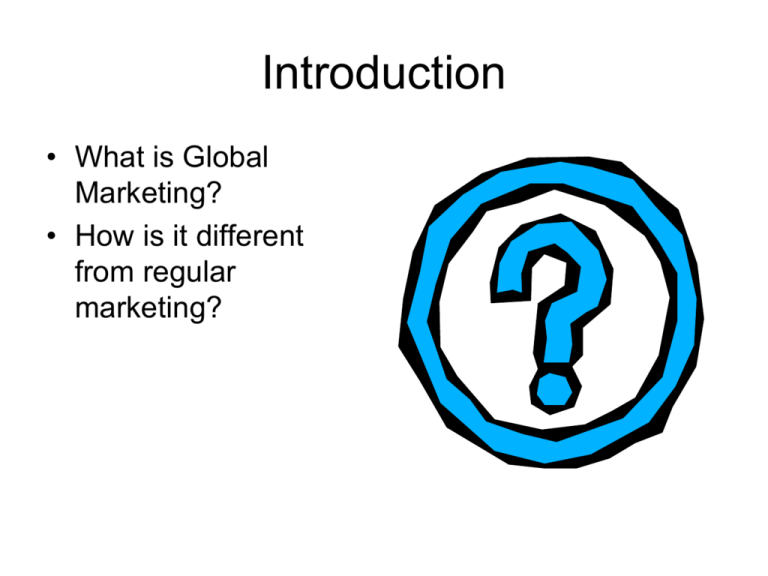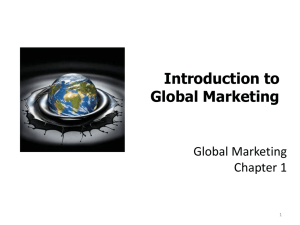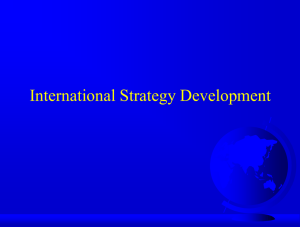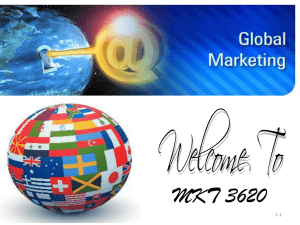Lecture - Module 1
advertisement

Introduction • What is Global Marketing? • How is it different from regular marketing? Introduction • Marketing – Process of planning and executing the conception pricing, promotion and distribution of ideas, goods and services to create exchanges that satisfy individual and organization goals • Global Marketing – Focuses resources on global market opportunities and threats; the main difference is the scope of activities because global marketing occurs in markets outside the organization’s home country Reasons for Global Marketing • Growth – Access to new markets – Access to resources • Survival – Against competitors with lower costs (due to increased access to resources) • Other – Economies of scale – Transfer of experience – Uniform global image Invented Here, Made Elsewhere U.S. Invented Technology Phonographs 9 0% 1% 9 0% Color TVs 1 0% 1970 4 0% Audiotape Recorders 0% NOW 1 0% Videotape Recorders 1% 9 9% Machine Tools 3 5% Telephones 9 9% 2 5% 8 9% Semiconductors 6 4% 9 8% Computers 7 4% 0 20 40 60 80 100 4 Overview of Marketing • One of the functional areas of a business that is distinct from finance and operations • Primary tools in marketing are product, price, place, and promotion • Marketing is an activity that comprises the firm’s value chain • Current trend is to involve marketers in all value-related decisions – called boundaryless marketing The International Marketing Task Foreign environment (uncontrollable) 1 Political/legal forces 7 Cultural forces Domestic environment (uncontrollable) Political/ legal forces (controllable) Price Promotion 6 Geography and Infrastructure Economic forces 2 Competitive structure Competitive Forces Product Channels of distribution 7 Level of Technology Economic climate 5 4 Structure of distribution 3 Environmental uncontrollables country market A Environmental uncontrollables country market B Environmental uncontrollables country market C 6 Boundaryless Marketing • Goal is to eliminate communication barriers between marketing and other business functional areas • Properly implemented it ensures that a market orientation permeates all value creating activities Goal of Marketing • Surpass the competition at the task of creating perceived value for customers • The Guide line is the value equation – Value = Benefits/Price (Money, Time, Effort, Etc.) Value Chain and Boundaryless Marketing Competitive Advantage • Success over competition in industry at value creation • Achieved by integrating and leveraging operations on a worldwide scale Globalization • Globalization is the inexorable integration of markets, nation-states, and technologies to a degree never witnessed before - in a way that is enabling individuals, corporations, and nationstates to reach around the world farther, faster, deeper and cheaper than ever before, and in a way that is enabling the world to reach into individuals, corporations, and nation-states farther, faster, deeper, and cheaper than ever before. » Thomas Friedman Global Industries • An industry is global to the extent that a company’s industry position in one country is interdependent with its industry position in another country • Indicators of globalization: – Ratio of cross-border trade to total worldwide production – Ratio of cross-border investment to total capital investment – Proportion of industry revenue generated by companies that compete in key world regions Competitive Advantage, Globalization and Global Industries • Focus – Concentration and attention on core business and competence Nestle is focused: We are food and beverages. We are not running bicycle shops. Even in food we are not in all fields. There are certain areas we do not touch…..We have no soft drinks because I have said we will either buy Coca-Cola or we leave it alone. This is focus. Helmut Maucher Global Marketing: What it is and What it isn’t • Strategy development comes down to two main issues similar to single country marketing – Target market – Marketing Mix Global Marketing: What it is and What it isn’t Global Marketing: What it is and What it isn’t • Global marketing does not mean doing business in all of the 200-plus country markets • Global marketing does mean widening business horizons to encompass the world in scanning for opportunity and threat Standardization versus Adaptation • Globalization (Standardization) – Developing standardized products marketed worldwide with a standardized marketing mix – Essence of mass marketing • Global localization (Adaptation) – Mixing standardization and customization in a way that minimizes costs while maximizing satisfaction – Essence of segmentation – Think globally, act locally Standardization versus Adaptation The Importance of Global Marketing • For US-based companies, 75% of sales potential is outside the US. – About 90% of Coca-Cola’s operating income is generated outside the US. • For Japanese companies, 85% of potential is outside Japan. • For German and EU companies, 94% of potential is outside Germany. Management Orientations Ethnocentric: Home country is Superior, sees Similarities in foreign Countries Regiocentric: Sees similarities and differences in a world Region; is ethnocentric or polycentric in its view of the rest of the world Polycentric: Each host country Is Unique, sees differences In foreign countries Geocentric: World view, sees Similarities and Differences in home And host countries Globalization Drivers Advances in Technology Communication & Transportation Costs Market Emergence of low cost NICs Convergence of incomes Globalization Potential Government Competition Creation of trading blocks Rise of new global competitors







